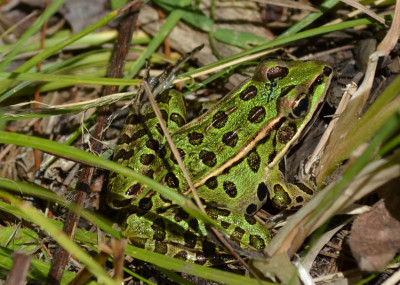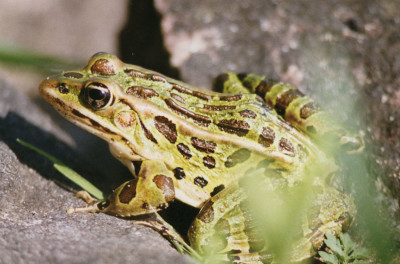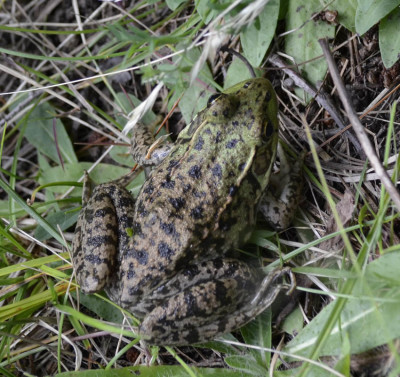If you ask most people where frogs live, they will answer in a swamp. It’s true, too, that Green Frogs and Bullfrogs are more common in a swamp or marsh than on dry land. There are Canadian frogs, like the Gray Treefrog, though, that aren’t usually at water or ground level at all. And there is a type of frog that prefers to hop through the grass to escape you rather than to jump in the water.
Meet the Northern Leopard Frog
Probably because of its multitude of green spots, the frog I’m talking about is called a Northern Leopard Frog. The spots are usually dark with a lighter rim (although you’ll notice on mine there isn’t any light rim!) and are rounded not sharp-edged. Leopard frogs usually have a white underside and a green or brown back.
According to the Ontario Nature website, these are very adaptable frogs and they are found in prairies, woodlands and tundra. They don’t need to sit in the water and are often found quite a ways inland.
According to the Alberta Fish and Wildlife website, the Leopard Frog’s relatively large size allows it to conserve water so the frogs can travel into “drier habitats in search of food.” (While that may be true, Bullfrogs and Green Frogs are even larger and don’t usually move so far inland, from what we’ve seen.) I agree with the website when its says that after it rains or if there has been a heavy dew, it’s more likely you’ll find Leopard Frogs further away from any water.
Where In Canada Are Northern Leopard Frogs Found?
While there are 7 other kinds of Leopard Frog in North America, the only one common in Canada is the Northern, according to the Ontario Nature website. The Northern is found throughout Canada, from sea to shining sea.
While they seem to be doing well in eastern Canada, they aren’t faring so well in the west. According to the B.C. Frogwatch Program website, “The Northern Leopard Frog is one of the species most at risk in B.C.” They are down to one location in B.C. after an unexplained die off of millions of frogs in the 1970s. A similar large decline affected the eastern half of Alberta, according to the Alberta Fish and Wildlife website.
Is the Decline of Bats Due to White Nosed Syndrome Helping the Frogs?
This summer we drove along a dirt county road in south eastern Ontario, not far from Sharbot Lake, after nightfall. The air was thick with insects and the headlights picked out at least a dozen frogs on a few kilometres of road. We drove even more slowly than normal to make sure they had time to leap to safety.
The swarms of bugs were a surprise to me. When I spoke with some others about it, however, a ghastly possibility or probability was mentioned: the insects are out of control because there are no bats left to catch them.
The population of Little Brown Bats has been decimated by a fungus man brought to North America. It grows on the noses and wing membranes of hibernating bats and wakens them. According to the Ontario Ministry of Natural Resources website, the wing membrane helps bats maintain their water balance. When the fungus interferes, the bats wake up because they are thirsty. The excessive use of energy in the winter results in huge numbers of bats dying.
Certainly we no longer see flocks of bats swooping over the lake surface at dusk. The O.M.N.R. says Ontario bat populations have dropped by more than 90% in 8 hibernation sites. “Bats at more than three quarters of Ontario’s hibernation sites are at high risk of disappearing due to white nose syndrome. Mass die-offs mean that there are no individuals left to reproduce.”
The only possible upside is that perhaps the frogs will be able to enjoy increased reproductive success due to this abundance of easily-caught insect prey. I’m not sure, though, how much overlap there is between the types of insects that the bats ate and those that the frogs can catch.
Not Every Frog on Land is a Leopard Frog
This frog nearly fooled us because it was hiding in the long grasses along with several Northern Leopard Frogs. When you look at it, though, you’ll notice the marks are more splotches than rounded dots. And the ridge down the back kind of stops partway along. And the hind legs are banded not spotted. That’s because this imposter is a Green Frog!
Interesting Frog Fact I Didn’t Know: We Have Mountain Frogs!
Until reading up on Northern Leopard Frogs, I didn’t know Canada had a species of frog that lives in the Alberta mountains up to 2000 metres (6 600 feet) above sea level. It’s called the Columbia Spotted Frog.
Related Reading
- If you see a little brown bat, please report it to the Natural Heritage Information Centre, as described on the O.M.N.R. website.
- What Animal is Playing a Banjo Badly in that Swamp?
- What Tadpoles are Forming a Wiggling Black Line Against the Water’s Edge and Why?
Join In
Have you ever been startled by a group of Leopard Frogs leaping away from your feet as you walk through tall grass? Please share your amphibian encounters with a comment.



